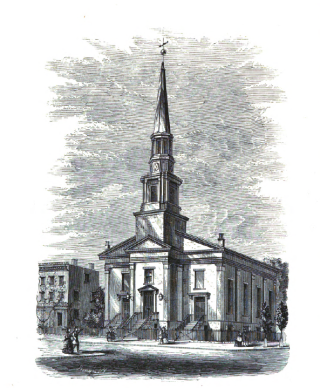The South Third Street Presbyterian Church of Williamsburgh is one of the oldest congregations in Williamsburg. The church was organized on April 19, 1844 in a meeting held at the public school at South Third Street and Fifth Street (Driggs Avenue) - across the street from the current church. The church was founded with 27 members, most of whom came from the First Presbyterian Church of Williamsburgh.1 The schism from First Presbyterian was doctrinal, a disagreement among congregants of First Presbyterian who wished to transfer the affiliation of the church to the Old School. The displaced congregants worshipped in the public school from April of 1844 to December of 1845. Nathaniel S. Prime served as the first minister to the congregation, stepping down in February 1845. Rev. Prime was replaced by P. E. Stevenson, who served until October, 1846, when he was succeeded by John Hamilton who was installed on October 11.2
The land for the church, at the northwest corner of South 3rd Street and Driggs Avenue, was sold to the congregation at “nominal price” by G. C. Furman. The cornerstone for the original church was laid on August 18, 1845. The basement (lower level) was completed and occupied on December 4, 1845 and the entire building was dedicated on May 10, 1846.3 The original church (demolished in the late 1960s) was constructed of brick, 62’ by 75’.4 The following year (1851), a parsonage was constructed next door. At the time of the church dedication the congregation numbered 153 members.5
The church helped to seed a number of other congregations, with all of the departures seeming to be amicable (as opposed to schismatic). In 1850, a number of congregants (“some of our best workers”) left to help form the New England Congregational Church on South 9th Street; in 1854 18 families left to form the Ainslie Street Presbyterian Church; in the early 1860s, it “gave most of the members and families that entered in the organization of Throope [sic] Avenue Presbyterian Church; and in 1864, 27 members left to form the Ross Street Presbyterian Church .6 According to an 1881 Eagle article, the church at that time owned two chapels, a brick chapel on Throop near Flushing Avenue and a frame chapel at Throop and Willoughby.7.
John Dunlap Wells was perhaps the best known of the ministers of South Third Presbyterian. His obituary, in October of 1903, describes him as “the last of four famous clergymen of the Eastern District”, the other three being Rev. Sylvester Malone of Ss. Peter & Paul Church, and Rev. S. M. Haskins of St, Mark’s Episcopal, and Elbert F. Porter of the Bedford Avenue Congregational Church.8
Wells was born in Whitesboro, N.Y. on October 25, 1815, the son of Solomon Wells and Marion (Dunlap) Wells.9 In grammar school, he studied under Rev. Nathaniel S. Prime at the Washington Academy and later at the Mount Pleasant Academy at Sing Sing.10 Wells graduated from Union College in Schenectady, N.Y. in 1838 and from the theological seminary at Princeton, N.J. in 1844, being licensed to preach by the North River Presbytery in 1843.11 Wells' first pastoral assignment, in the summer of 1845, was in a private chapel for James Lenox in New Hamburg, New York. Later that year, Wells was made pastor of a chapel in New York at Madison and East 29th Street (later the Madison Avenue Presbyterian Church), under the patronage of Lenox's sisters. In 1847, after a brief period preaching in Indian territory, Wells took over leadership of the parish church of the First Presbyterian Church (New York), on 12th Street. It was at this time that Wells married his wife, Jessie Henderson.12
Wells took over leadership of the South Third Presbyterian Church in January, 1850. In 1882, Wells' son, Rev. Newell Woolsey Wells, was elected as co-pastor of the church. The two served as co-pastors until the elder's death in 1905.13
- 1John D. Wells, A Brief History of the South Third Street Presbyterian Church, Williamsburgh, L.I.(New York: Sutton, Bowne & Co., 1870), 8.
- 2Wells, 8-9.
- 3Wells, 9.
- 4Henry R. Stiles, ed., Civil, Political, Professional and Ecclesiastical History of the County of Kings and the City of Brooklyn from 1683 to 1884(New York, N.Y., United States: W.W. Munsell, 1884), 759.
- 5Wells, 11.
- 6Wells. 12-13; 19; 22.
- 7“The South Third Street Presbyterian Church, Williamsburg: Twenty-Fifth Anniversary,” Brooklyn Daily Eagle, April 19, 1869: 11.
- 8“Dr. Wells, Aged Preacher, Dies While Making Call,” Brooklyn Daily Eagle, October 31, 1903.
- 9Peter Ross and William S. Pelletreau, A History of Long Island: From Its Earliest Settlement to the Present Time (New York, N.Y.: Lewis Publishing Co., 1903).
- 10“Dr. Wells, Aged Preacher, Dies While Making Call,” Brooklyn Daily Eagle, October 31, 1903.
- 11Ross and Pelletreau
- 12Brooklyn Church Semi-Centennials, vol. XV, Brooklyn Eagle Library 3 (Brooklyn, N.Y.: Brooklyn Daily Eagle, 1900), 37-38.
- 13Brooklyn Church Semi-Centennials, vol. XV, Brooklyn Eagle Library 3 (Brooklyn, N.Y.: Brooklyn Daily Eagle, 1900), 38.
